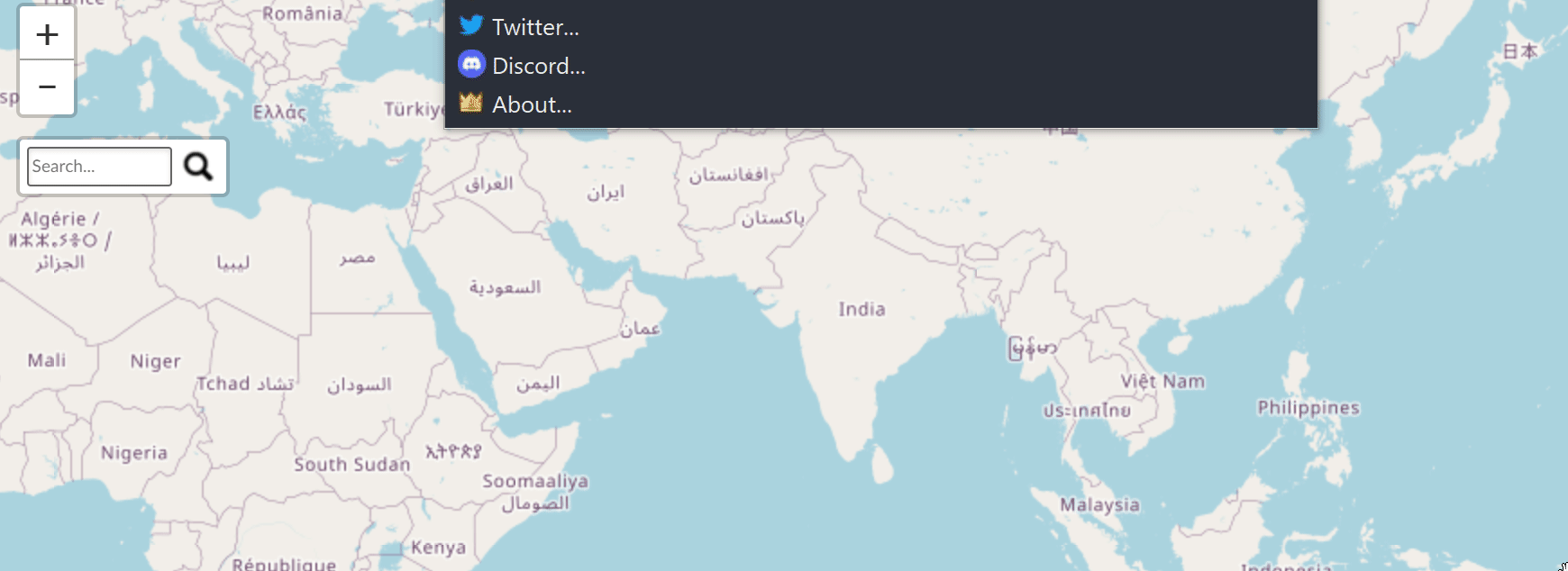Hi everyone!
Hopefully you can help me out. I am trying to make a Bokeh map using the ACLED dataset [link to specific dataset]. I can successfully create the map with an interactive legend where the user can hide datapoints by category.
The ACLED dataset also contains information about the date of the event. To make use of this, I wanted to use Bokeh’s DateRangeSlider to render a map that is updated with event data within a specific date range.
This is where I run into problems. The map and DateRangeSlider are successfully rendered into a HTML-file, but I’m struggling to link the two so that the map updates to the date range specified by the DateRangeSlider. For the DateRangeSlider to work, you need to specify some Javascript using CustomJS from the Bokeh package.
Would greatly appreciate some help - you’ll find the relevant Javascript at the bottom of the code. GIF of the map here
Full code below:
import pandas as pd
import numpy as np
import datetime
import warnings
warnings.filterwarnings('ignore')
from bokeh.models import *
from bokeh.models.callbacks import *
from bokeh.plotting import *
from bokeh.io import *
from bokeh.tile_providers import *
from bokeh.palettes import *
from bokeh.transform import *
from bokeh.layouts import *
#See link above
df = pd.read_csv('ethiopia_2019.csv')
#Intiate map scaling and create map
scale = 2000
x=df["x"]
y=df["y"]
x_min=int(x.mean() - (scale*350))
x_max=int(x.mean() + (scale*350))
y_min=int(y.mean() - (scale*350))
y_max=int(y.mean() + (scale*350))
tile_provider = get_provider(STAMEN_TONER)
p = figure(
title='2019 Ethiopia by category (circle size weighted by fatalities)',
match_aspect=True, #?
tools='wheel_zoom, pan, reset, save',
x_range=(x_min, x_max),
y_range=(y_min, y_max),
x_axis_type='mercator',
y_axis_type='mercator',
plot_width=1000,
plot_height=700
)
p.grid.visible=True
m=p.add_tile(tile_provider)
m.level='underlay'
p.xaxis.visible=False
p.yaxis.visible=False
events = list(['Protests', 'Riots', 'Strategic developments', 'Violence against civilians', 'Battles', 'Explosions/Remote violence'])
events
#Creating empty lists to create temporary dataframes for each category
Protests=[]
Strategic_developments=[]
Riots=[]
Battles=[]
Explosions_remote_violence=[]
Violence_against_civilians=[]
list_list=[Protests,Riots,Strategic_developments,Violence_against_civilians,Battles,Explosions_remote_violence]
#New column with radius size of Bokeh circle markers
df.loc[df['fatalities']==0, ['radius']]=4000
df.loc[(df['fatalities']>0) & (df['fatalities']<=10), ['radius']]=12000
df.loc[(df['fatalities']>10) & (df['fatalities']<=30), ['radius']]=24000
df.loc[(df['fatalities']>30) & (df['fatalities'] <=50), ['radius']]=36000
df.loc[(df['fatalities']>50), ['radius']]=50000
#Append data to relevant event_type category
for i in range(len(df['event_type'])):
if df.loc[i,'event_type']=='Protests':
Protests.append([df.loc[i,'event_type'],
df.loc[i,'x'],df.loc[i,'y'],
df.loc[i,'actor1'],
df.loc[i,'notes'],
df.loc[i,'fatalities'],
df.loc[i,'radius'],
df.loc[i,'source'],
df.loc[i,'event_date'],
df.loc[i,'DateTime'],
df.loc[i,'location']])
if df.loc[i,'event_type']=='Riots':
Riots.append([df.loc[i,'event_type'],
df.loc[i,'x'],df.loc[i,'y'],
df.loc[i,'actor1'],
df.loc[i,'notes'],
df.loc[i,'fatalities'],
df.loc[i,'radius'],
df.loc[i,'source'],
df.loc[i,'event_date'],
df.loc[i,'DateTime'],
df.loc[i,'location']])
if df.loc[i,'event_type']=='Battles':
Battles.append([df.loc[i,'event_type'],
df.loc[i,'x'],df.loc[i,'y'],
df.loc[i,'actor1'],
df.loc[i,'notes'],
df.loc[i,'fatalities'],
df.loc[i,'radius'],
df.loc[i,'source'],
df.loc[i,'event_date'],
df.loc[i,'DateTime'],
df.loc[i,'location']])
if df.loc[i,'event_type']=='Strategic developments':
Strategic_developments.append([df.loc[i,'event_type'],
df.loc[i,'x'],df.loc[i,'y'],
df.loc[i,'actor1'],
df.loc[i,'notes'],
df.loc[i,'fatalities'],
df.loc[i,'radius'],
df.loc[i,'source'],
df.loc[i,'event_date'],
df.loc[i,'DateTime'],
df.loc[i,'location']])
if df.loc[i,'event_type']=='Explosions/Remote violence':
Explosions_remote_violence.append([df.loc[i,'event_type'],
df.loc[i,'x'],df.loc[i,'y'],
df.loc[i,'actor1'],
df.loc[i,'notes'],
df.loc[i,'fatalities'],
df.loc[i,'radius'],
df.loc[i,'source'],
df.loc[i,'event_date'],
df.loc[i,'DateTime'],
df.loc[i,'location']])
if df.loc[i,'event_type']=='Violence against civilians':
Violence_against_civilians.append([df.loc[i,'event_type'],
df.loc[i,'x'],df.loc[i,'y'],
df.loc[i,'actor1'],
df.loc[i,'notes'],
df.loc[i,'fatalities'],
df.loc[i,'radius'],
df.loc[i,'source'],
df.loc[i,'event_date'],
df.loc[i,'DateTime'],
df.loc[i,'location']])
#Create circle markers in Bokeh, use hovertools to append info to the markers
for i in range(len(list_list)):
temp_df=pd.DataFrame(list_list[i],columns=['event_type','x','y','actor1','notes', 'fatalities', 'radius', 'source', 'event_date', 'DateTime', 'location'])
source=ColumnDataSource(temp_df)
source2=ColumnDataSource(temp_df)
circle1=p.circle(x=('x'),y='y',source=source,color=Spectral6[i],line_color=Spectral6[i],legend_label=events[i],hover_color='white',radius='radius', fill_alpha=0.4)
event_hover = HoverTool(tooltips=[('Location', '@location'),
('Date', '@event_date'),
('Fatalities', '@fatalities'),
('Actor','@actor1'),
('Category','@event_type'),
('Description','@notes'),
('Source', '@source')],
mode='mouse',
point_policy='follow_mouse',
renderers=[circle1],
formatters={'DateTime': 'datetime'})
event_hover.renderers.append(circle1)
p.tools.append(event_hover)
#Define callback (CustomJS in Bokeh) to use with DateRangeSlider
##ISSUE: CALLBACK OPTION 1##
#https://stackoverflow.com/questions/64610234/bokeh-custom-js-callback-date-range-slider
callback = CustomJS(args=dict(source=source, ref_source=source2), code="""
// print out array of date from, date to
console.log(cb_obj.value);
// dates returned from slider are not at round intervals and include time;
const date_from = Date.parse(new Date(cb_obj.value[0]).toDateString());
const date_to = Date.parse(new Date(cb_obj.value[1]).toDateString());
console.log(date_from, date_to)
// Creating the Data Sources
const data = source.data;
const ref = ref_source.data;
// Creating new Array and appending correctly parsed dates
let new_ref = []
ref["DateTime"].forEach(elem => {
elem = Date.parse(new Date(elem).toDateString());
new_ref.push(elem);
console.log(elem);
})
// Creating Indices with new Array
const from_pos = new_ref.indexOf(date_from);
const to_pos = new_ref.indexOf(date_to);
// re-create the source data from "reference"
data["DateTime"] = ref["DateTime"].slice(from_pos, to_pos);
source.change.emit();
""")
#View the maps
p.legend.location = "top_right"
p.legend.click_policy="hide"
date_range_slider = DateRangeSlider(value=(df['DateTime'][len(df['DateTime'])-1], df['DateTime'][0]),
start=df['DateTime'][len(df['DateTime'])-1], end=df['DateTime'][0])
output_file(filename="bokeh.html", title="title")
date_range_slider.js_on_change('value', callback)
layout = column(p, date_range_slider)
output_notebook()
show(layout)


